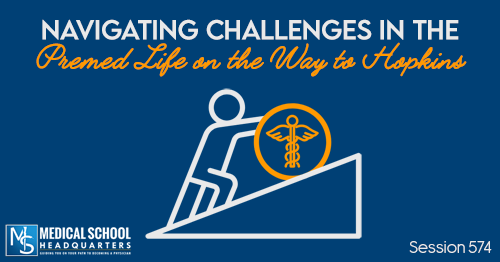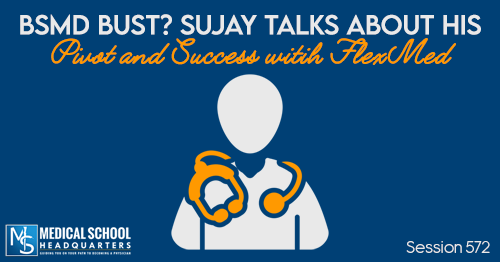Apple Podcasts | Google Podcasts

Session 372
Patrick Ridge, Ph.D. is joining me to help launch a brand new podcast and help premeds become better advocates through Spanish language and cultural knowledge!
Go to SpanishForPremeds.com and sign up to be notified when this podcast launches.
As healthcare providers, it’s our responsibility to make sure that our patients get the best possible care. That includes understanding cultural differences and providing a safe place to communicate in their language.
This new podcast is going to be a dive into Spanish for premed students. It’s not going to make you a fluent Spanish speaker. But the goal of this podcast is for you to understand a lot of the reasons behind learning some basic Spanish.
'It's important to understand basic Spanish when it comes to speaking with patients.'Click To TweetIf you haven’t yet, check out our free resources on Meded Media and join our community on PremedHangout.com.
Listen to this podcast episode with the player above, or keep reading for the highlights and takeaway points.
[03:19] About Dr. Patrick Ridge
Patrick Ridge is a professor at Virginia Tech. He’s an assistant professor of Spanish in the Department of Modern and Classical Languages and Literatures. His current research focus is on the literary and cultural representations of soccer in Latin America. He also specializes in film and media studies.
He has published on the documentaries of World Cup 1978 in Argentina, homoaffectivity in the Mexican Netflix series Club de Cuervos, masculinity in Brazilian soccer films, and violence in contemporary Spanish cinema.
He has recently taught courses on Latin American documentary, soccer, and Mexican and Central American literature and culture.
As a certified medical interpreter, he also teaches Spanish for the Medical Professions. He earned his Ph.D. in Spanish from Arizona State University and MA from the University of Louisville.
Patrick is not a native Spanish speaker but he started learning Spanish in his first grade and all the way to high school. He initially wanted to be a doctor. he took Calculus and Biology but didn’t work out well. He studied abroad and he loved the opportunity of meeting different people and learning different cultures. The reason he got his Ph.D. in Spanish.
[Related episode: A Non-traditional Premed Turned Medical Spanish Podcaster!]
[11:14] Translating vs. Interpreting
Interpretation is the spoken word while translation is the written word. These words are often used erroneously in everyday interaction. This could be because of popular culture.
[13:33] The Importance of Speaking the Language of Your Patients
Any patient feels a little more vulnerable. There’s always that question of fear. Add that to having little knowledge of English. This amplifies the fear that is already there in the patient going into the clinic.
A lot of times, medical terminologies are complex. Knowing that you have someone who speaks your language eliminates that fear among patients.
'Learning their language preserves the patient-provider relationship.'Click To TweetIf you don’t have access to an interpreter, it leads to communication breakdown and overall the quality of care is affected as well.
[18:18] Understanding the Nuances from a Cultural Perspective
If a patient, for instance, says they have empacho (equivalent to stomach cramps or indigestion) or susto (an equivalent of post-traumatic stress.) Susto literally means fear or afraid. It’s beneficial for the provider to understand that susto is a cultural bound syndrome.
Understanding something like that comes back to improving the treatment and the diagnosis of the patient and what they’re feeling in that instance.
'It's essential to understand how pain or sickness is described and interpreted within that culture.'Click To TweetIt’s also essential to have a base knowledge of how Hispanic names work. A lot of times, Spanish speaking patients will have two last names. The first last name would be the paternal last name and the second would be the maternal or the mother’s maiden name.
This is very important when it comes to filing. Not having an understanding of this leads to confusion. They end up either creating multiple files for that patient or it becomes wrongly filed. Hence, a lot of Spanish speakers in the U.S. hyphenated their last names.
Another important thing to understand would be the home remedies used by Spanish speaking patients. There are seven cases of people using Coca-Cola as a treatment for high blood pressure. Or camomile tea as a remedy for indigestion is very prevalent within Spanish speaking households. Knowing there are differences will lead you to ask the right questions.
[23:22] The Role of the Interpreter
The interpreter is not there to interpret what’s not said. They’re there to relay the message that you say. So if you don’t say it or ask the right question, he/she is not going to interpret that.
'You have to know sometimes the right questions asked.'Click To TweetCertified medical interpreters will also know when to become an advocate and to stop the interpreting process and try to explain something that might be lost in the communication. That said, it’s important to know that the interpreter is only going to be interpreting what you say. Sometimes, you have to fill in the gaps.
If he/she is a certified medical interpreter, they would usually stop the session if they see or notice that maybe something is at loss here in the way the message is sent. They will stop both parties to explain and clarify things.
For example, if the provider isn’t getting what susto is, the medical interpreter would explain and clarify what it is.
It’s also important for the provider to take into account whether patients understood any translated materials presented to them. The patients may have questions or they might be illiterate. This is when the interpreter would speak up and become an advocate.
That being said, the same happens with English speaking patients as providers don’t really take the time to make sure patients can read what they’re given.
[29:10] For Students That Speak Zero Spanish
Patrick recommends learning basic phrases such as when you’re introducing yourself to the patient. There’s also a difference between formal and informal Spanish. Especially with older patients, there’s a certain degree of respect that you have to show to them.
'Learning some basic Spanish terms really helps to eliminate the fear that patients might have.'Click To TweetAvoid raising your voice with the hope that you’re going to make them understand better. They might find this offensive. They’re not deaf. They just don’t speak English.
There are a lot of good books that you can use for learning basic phrases and terminology.
As a professional or provider, take note of some of the phrases you use on every patient encounter. Examples would be phrases like why they’re coming today or how they rate their pain on a scale of 1-10.
Understand the things that you ask your patients everyday. Try to build up a bank of expressions you can use. There are also online resources you can use such as actual recordings by native speakers to help you with practicing some expressions.
[32:40] Learning Medical Terminologies in Both Languages at the Same Time
'Sometimes, even just pronouncing some of these words in English can be a tough task.'Click To TweetYou can learn both languages side-by-side using bilingual sources like MedlinePlus and Mayo Clinic. Try to research in English first and then there’s a button for Spanish. This is, at least, for the written source.
It may not help with pronunciation. But it can help with your translations especially if you need to be translating documents for your practice.
If you’re working with an interpreter or you have access to them, ask for some help too so you can learn through practice. Maybe record a conversation with them.
[35:25] Why Learn Spanish When We’re in The States?
'There are 60 million Spanish speakers in the United States.'Click To TweetAfter Mexico, the United States has the second-largest Spanish speaking population in the world. Third is Colombia and then followed by Argentina and Spain.
You also have to understand the history of Spanish in this country. There’s the Mexican-American war which is also interesting because while this is what it’s called in English, in Spanish, it’s called the U.S invasion n Mexico.
There have been millions of Spanish speakers in Mexico before 1848, before the conflict. That territory included Texas and states have a Hispanic name like Montana, Colorado, California, etc.
People fail to take into consideration the long history of Spanish speaking populations in the United States.
Also, consider the Bracero Program in the 40’s where the U.S. relied on the labor from people south of the border.
People need to understand this is a large part of our population. Part of being a healthcare provider is to understand who are your patients.
Moreover, this is legally required by Title VI of the Civil Rights Act and some providers might not even be aware of this. The access to an interpreter is a right, if the hospital or clinic receives federal funds.
[40:40] Finding Resources for Premed Students
Find what you like. There are a variety of podcasts that you can find. Check out Radio Ambulante hosted by Daniel Alarcon. It’s a bilingual podcast. There are some medical episodes sometimes.
You can also find movies, news, or something within popular culture that’s entertaining. At least expose yourself to the daily interactions presented in that media.
Find access to free clinics that offer interpreting services. Try to volunteer at those places to expose yourself, not only to other cultures but to the Spanish language itself.
'Find opportunities. Find ways to engage with those communities.'Click To Tweet










